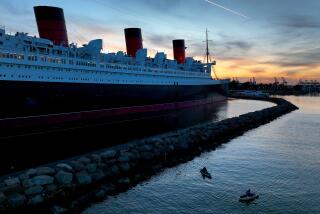She’s Not Just Another Retiree in From the Cold
- Share via
IN WHAT WAS ONCE THE QUEEN MARY’S FIRST-CLASS RESTAURANT, the Little Big Band is swirling swing tunes around two dozen elderly couples who smilingly navigate across the dance floor. It’s 12:30 on a weekday afternoon. High on the wall opposite the band, itself an aggregation of white-haired heads, is the ship’s famed map of the North Atlantic Ocean with its crystal replica of the Queen Mary. The replica, on a track mimicking the ship’s route, is meant to show the vessel’s present location on its 41/2-day Southampton-New York run; currently, it is somewhere mid-ocean.
Except, of course, that the Queen Mary isn’t. It’s here in Long Beach, floating in flat water about 6 feet from the harbor bottom.
The only surviving grande dame of ocean-going’s Golden Age is now a shoulder shrug to many locals. The Queen Mary has been turned into a hotel and conference center, and on Dec. 9 she’ll have been staring sidelong through many-windowed eyes at the Long Beach skyline for 33 years, exactly as many as she traveled the seas.
Some people have long considered the Queen Mary the ultimate white elephant, brought to incongruous pasture at the edge of a sunny desert after being built for the cold and stormy North Atlantic. They look upon Long Beach’s $3.45-million acquisition of her as an abiding act of folly.
The fact is, however, that under the hand of the 7-year-old nonprofit RMS Foundation, the Queen Mary is attracting 1.5 million visitors a year and generating $40 million in annual revenue. After years of losses and management crews that abandoned ship, she is making about $3.5 million a year in profit, all of which goes into her continued restoration. In addition, she poured into Long Beach’s public treasury about $2.5 million in rent, taxes and fees last year.
No doubt, the ship’s sheer, imperturbable immensity, permanently removed from the vastness of the sea, contributes to its being perceived as seriously out of place. Its interior, moreover, bespeaks the certitudes of a time not long past, yet eons removed from current sensibilities.
In the heyday of her operating life, the Queen Mary was a seaborne version of the British caste system, with enormous spaces and every sort of luxury available only to first-class passengers.
First-class facilities were in the stable center of the ship, while the cramped third-class compartments were concentrated near its front, where the ship’s pitching and yawing, particularly in heavy seas, tended to produce a stomach-churning corkscrew motion.
Yet the Queen Mary is hardly the first retiree from an altogether different life to end up in Southern California. She has a great deal in common with those oldsters gliding and dipping their way around her once-exclusive restaurant.
She had been a big, spirited, buxom girl, for a time the fastest ocean liner on the North Atlantic, which was the world’s busiest sea lane. Her top-heaviness tended to make her pause disconcertingly long at the farthest reach of her sideways roll before righting herself. As she approached middle age, she had to be fitted with four 98-ton retractable stabilizers to provide, well, lift.
In the course of her life she underwent many refurbishings. Conscripted into World War II service as a troop transport, she was stripped of her finery and fitted top to bottom and stem to stern with hammocks and bunks. After brief duty in the South Pacific and the Indian Ocean, she was assigned to her native waters to ferry American soldiers, as many as 15,000 at a time, to England. She carried American war-wounded and German POWs back to America. Always she traveled unescorted, relying on her speed and a zigzag course to avoid German submarines.
She was a man-killer too. In October of 1942, the light destroyer Curacoa accidentally crossed her bow and she cut it in two, erasing the lives of 329 British sailors.
After the war, the Queen Mary was dolled up again for the luxury trade, but commercial air travel began eating into her first-class clientele.
With speed no longer her selling point, she touted her unhurried luxury to woo travelers. For a few years, she tried life as a cruise ship in the tropics, but she’d been built for cold weather (she had indoor swimming pools, inadequate air-conditioning). Modern cruise ships--more like hotels built on barges--offered more up-to-date amenities without the Queen Mary’s class consciousness.
Pounded into questionable condition by her years on the sea, overtaken by modern realities, she said goodbye to the life she knew and left for California. She even may have done it with relief.
So now the Queen Mary has returned to a distinct stateliness, which, if static and conspicuous, has proven prophetic. Long Beach, once hopelessly dependent on oil revenues, the U.S. Navy and a fading aerospace industry, is making an increasingly credible bid for a new seaside prosperity, with a burgeoning port, new aquarium and redone harbor.
To keep her presentable, the ship has been fitted with a low-voltage cathodic system, a kind of electrolysis to combat not hair but rust on her hull. Every decade or so, she is discreetly tipped a few feet so that her bottom can be scraped of accumulated marine vegetation. Her old-age toilette--the restoration of her expensive teak decks, for example--continues apace.
A fairly queenly retirement by any measure. May the band aboard her play on.
*
James Ricci’s e-mail address is james.ricci@latimes.com
More to Read
Sign up for The Wild
We’ll help you find the best places to hike, bike and run, as well as the perfect silent spots for meditation and yoga.
You may occasionally receive promotional content from the Los Angeles Times.






